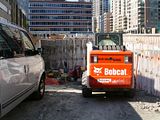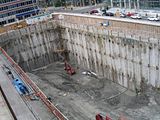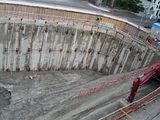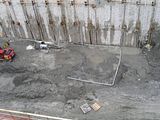Daily Commercial News
Here's an article good for interest / knowledge reading ~

*************
Slurry wall misses the cut at Burano
Novel excavation method would have been a first for Toronto
June 3, 2008
DON PROCTER, correspondent
It looks like Toronto will have to wait. The Burano, a 48-storey condo planned downtown, was billed as the first highrise in Toronto to use an unusual slurry wall excavation but minds have changed and a traditional caisson wall structure will be specified instead.
A slurry wall is a non-structural, watertight wall built below grade to keep the surrounding soil from caving in during excavation. The idea is to pour the slurry (a mix of water and bentonite clay) into the pit as it is being excavated to support the pit’s surrounding walls, explains Craig Slama, engineer, Jablonsky, Ast & Partners, structural engineers for the project.
While slurry wall excavations can be more expensive than caisson structures, a slurry wall allows builders to erect a tower while excavating the foundation. And, it can be done on a tight site (like the Burano) without the traffic lane closures normally associated with caisson construction, he says.
“That is where the main savings should have been realized but I guess after they (Lanterra Developments) worked through the numbers several times they found it wasn’t in their best interest to go with a slurry wall. Whether that was because it wasn’t cheaper or they didn’t want to risk going with an unknown technology, I don’t know.â€
Lanterra could not be reached for comment.
Slama says the slurry wall had been considered largely because of the nature of the soft soil and the deep foundation.
“Caisson walls have a little trouble with verticality. Even half a percent out of plumb at the top and they are really out of plumb at the bottom (of the seven-storey-deep foundation).
Slurry walls are commonly used in cities like Boston and New York. There, the procedure usually involves first pouring a concrete floor on solid ground, building supports underneath and then excavating the underside to the next lower floor and repeating the process until the excavation is completed.
In Toronto the method was different. “We had hoped to excavate the whole site and then start building normally,†says Slama.
Another engineering challenge has been how to deal with the potential impact of lateral winds on the tall, parallelogram-shaped tower. Before coming up with the final engineering analysis, a model of the Burano was put through a series of wind tests in a lab in Ottawa, explains the engineer.
The Burano will be built on the site of the former Addison on Bay Ltd. car dealership. Two of the two-storey heritage-designated limestone façades with brick infill (east and south elevations) will be dismantled piece-by-piece, catalogued and taken off site for restoration. The work will include a mild cleaning. “We don’t want it going back looking like a brand new building,†says Jeff Hayes, project architect of E.R.A. Architects Inc., the heritage architect for the development.
Part of the interior of the heritage car showroom will be replicated and incorporated into the podium of the new tower.
One of the requirements is that the new building columns be placed where the old building columns were. Replicas will be made from moulds of the original columns and capitals, says Slama, adding the goal is to reproduce much of the original interior that is located outside the footprint of the new tower.
Built in 1925, the Neo-Gothic-style building (originally called the Mclaughlin Motor Car Showroom) was the first poured concrete building constructed in a Toronto winter, says Hayes. At the time new methods of construction were employed, including materials transported to site in “heated†condition.
Storage space water and aggregate were all kept warm with salamanders and tarpaulins. Steam was used to heat the water, cement and aggregate during mixing.
Currently, Lanterra is securing working and building permit drawings for the project.
Construction could commence in the fall.
http://www.dcnonl.com/article/id27898







